Journal of Agricultural Science and Food Research
Open Access
ISSN: 2593-9173
ISSN: 2593-9173
Review Article - (2023)Volume 14, Issue 2
Groundnut (Arachis hypogaea L.) is one of nitrogen fixing legume, economically and nutritionally important crop for tropical and sub-tropical regions of the world. It is unique crop because, it flowers above ground and the nut develops underground. Worldwide groundnut produced by more than 110 countries. The production is estimated to 53.64 million tonnes during 2020 cropping season. The total land coverage of groundnut in Ethiopia is 113,515 ha and the production is estimated to be 205,069 tonnes with productivity of 1.81 tonnes per hectare. Oromya and Benishangule Gummuz regions were the leading respective producer regions in Ethiopia. Production area, yield and productivity has been increasing worldwide with a rate of 5.5%, 7.6% and 2.2% respectively, whereas, 143.74%, 23.5% and 1.5% respectively, during 2019 and 2020 cropping season. This revealed that, the rate of production increment in Ethiopia was highly dependent on area expansion than productivity. Therefore, breeding effort on yield improvement is vital solution to feed increasing population in the future. This paper addressed the trends and status of groundnut production in Ethiopia.
Groundnut; Production; Productivity; Groundnut plant
Groundnut (Arachis hypogaea L.) is one of leguminous oil crop, native to the Western Hemisphere, probably originated in South America, and its center of origin most likely is Brazil, where about 15 wild species are found [1]. Currently, it is cultivated in more than 110 countries with 31.57 million ha with a total production of 53.64 million tonnes during 2020. Depending on its production status groundnut is ranked fifth after oil palm, soybean, rapeseed, and sunflower in the world [2].
Groundnut is relatively new to Ethiopia. Italian explorers first introduced it during 1920's in to Hararge province in eastern Ethiopia, and hereafter disseminated to lowlands of Western Wollega, Gamogofa, Illubabor, Gojam, Shoa and Wollo [3]. Depending on its production status groundnut is ranked third in Ethiopia after Nuge and sesame. The total land coverage of groundnut in Ethiopia is 113,515 ha and the production is estimated to be 205,069 tonnes with productivity of 1.81 tonnes per hectare [4].
It has a tremendous potential to mitigating protein nutrition deficiency in poverty-ridden regions of the world. It contains 36% to 54% oil, 16% to 36% protein and 10 to 20% carbohydrates [5]. Groundnut plant can be used in different purpose; kernels for human consumption in raw and processed forms, branches, leaves and byproducts from oil processing as fodder for cattle, and nitrogen fixed from its root as nutrient for the soil [6]. Production and productivity of groundnut have been increasing worldwide with the rate of 7.6% and 2.2% respectively, while in Ethiopia the production and productivity increment was estimated to 23 % and 1.5%, respectively. On the other hand, area expansion was 5.5% worldwide and 143.74% in Ethiopia. The production and productivity of groundnut is mainly affected by both biotic (i.e., foliar disease, rosette virus, aflatoxin, weeds, etc.) and abiotic factors (i.e. drought, salinity). In addition, lack of mechanization hinders its production in the country. However, there was limited information on it. Therefore, this review paper gives insight about trends and current status of groundnut production in Ethiopia.
Origin and distribution of groundnut
Groundnut is native to the Western hemisphere. The natural distribution of all the Arachis species is confined to Argentina, Bolivia, Brazil, Paraguay, and Uruguay. It probably originated in South America where all wild species in the genus are found only in it, the center of origin most likely being Brazil, where about 15 wild species were found. Cultivated species of groundnut evolved through a single hybridization and polyploidization process. Successive selection during cultivation process resulted in a highly narrow genetic base of the cultivated species [7]. However, the Spanish explorers are credited with its spread throughout the New World. They introduced it to Europe whereas; it spread to Asia and Africa through trade. Groundnuts reached North America via the slave trade and commercial production of groundnuts in the USA began in about 1876. Italian explorers introduced groundnut to Hararge province in eastern Ethiopia during 1920's later on disseminated to the lowlands of Western Wollega, Gamogofa, Illubabor, Gojam, Shoa, and Wollo.
Taxonomy
Cultivated groundnut (Archis hypogaea L.) is described as Arachis (from the greek word Arachus), meaning weed, and hypogaea meaning underground chamber, referring to the formation of pods in the soil. It is self-pollinated, allotetraploid (2n=4x=40) with little polymorphism at the molecular level [8]. It belongs to the family Fabaceae, genus Arachis. It includes 80 diploids and tetraploids species, of which A. hypogaea L. is the most important and widely cultivated. Cytologically, it is like diploid, but it is a segmental amphidiploid. Its flower arranged on the main axis, and classified in to two depending on its flower arrangement subspecies subsp. fastigiata and subsp. hypogaea. The fastigiata subsp. is comprised of four botanical varieties, var. vulgaris, var. fastigiata, var. peruviana, and var. aequatoriana, while based on inflorescence, pod, and seed characteristics hypogaea is divided into two varieties, var. hypogaea and var. hirsuta.
Botany
Groundnut (Arachis hypogaea L.), also called the peanut and earthnut, among other names, is technically a pea not a nut. It is unique plant because it flowers aboveground, but fruits belowground. It is a self-pollinated legume with a central, upright stem and many lateral branches. It bears numerous branches that vary from prostrate to nearly erect. It is an annual herbaceous plant growing 30 cm to 50 cm tall. The leaves are green or dark green in color opposite; pinnate with four leaflets each leaflet 1 cm to 7 cm long and 1 cm to 3 cm broad. Darker leaves are found in Virginia groundnut, while Spanish and Valencia groundnut tend to have lighter leaves [9].
Morphology
Groundnut flowers above ground, however it's able to penetrate its own seeds as a result of the expansion of a specialized organ referred to as gynophore. The flowers are 1.0 cm to 1.5 cm across, and yellowish orange with reddish veining. During fertilization, the ovary begins to enlarge through the peg or gynophore, elongates to push the ovary into the soil for fruit development. Gynophore is sensitivity to light, touch, and gravity, and it helps to insert into the soil. Physiological changes occur when gynophore has formed; plant hormone accumulation and distribution take place throughout its development.
Groundnut fruit contain 1 seed-6 (but usually 1-3) seeds and it covered by an indehiscent pod. The pods form predominantly underground. However, there was evidence which mutants with aerial podding have been developed. Aerial podding is conditioned by dominance or partial dominance. It is one of cleistogamous plant, but outcrossing occurs at the rates of less than 1% to greater than 6% (<1% >6%) due to atypical flowers and action of bees [10].
Groundnut has alternate or sequential branching habit and a taproot system. Most roots are producing nodules for biological nitrogen fixation. Nodulation in groundnut is very essential in symbiotically fixing N2 which can be made available to crops that succeed the groundnut.
Classification of groundnut
Groundnut (Archis hypogaea L.) is grouped into two, based on the nut’s arrangement at the base of the stem. In bunch types, the nuts are closely clustered about the base and they are designated as Valencia or Spanish groundnut, while in runner types the nuts are scattered along prostrate branches that radiate and they are called Virginia groundnut. The branching pattern in peanut may be alternate or sequential. Virginia types have alternate branching, a trait that is generally believed to be dominant over the sequential branching of Spanish and Valencia peanuts.
Depending on the presence or absence of reproductive axes (inflorescence) on the main stem and the arrangement of reproductive and vegetative axes on the primary laterals groundnut grouped in to two. The first is, Virginia type, is characterized by the absence of reproductive axes on the main stem. It has dark-green foliage and large pods and largest seeds. It has an alternate branching pattern, where the first two branches on the primary lateral are always vegetative. The second is, Spanish or Valencia group has reproductive axes in a continuous series on successive nodes of lateral branches, on which the first branch is always reproductive. It has a sequential branching pattern. It is early maturing and the plant is generally erect and has pods clustered about the base of the plant while the seeds possess little fresh dormancy. The Virginia type, on the other hand, is late maturing and has pods dispersed along the secondary and tertiary branches and the seeds possess appreciable fresh dormancy.
Climatic requirement
Groundnut is a tropical plant and requires a long and warm growing season. The optimum temperatures for growing groundnuts range from 25°C to 35°C. Cooler temperatures, especially at night, prolong the growing cycle. Groundnuts are slightly sensitive to photoperiod. Although groundnut is drought tolerant, good performance is strongly linked to adequate soil water content at sowing time, followed by welldistributed rainfall. Early maturing small-seeded varieties require 300 mm-500 mm while the medium to late maturing large seeded varieties need 1000 mm-1200 mm rainfall. Although groundnut is predominantly a crop of the tropics, the approximate limits of present commercial production are between latitudes of 40°N and 40°S and 367 up to altitude of 2300 m.a.s.l. range of altitude where rainfall during the growing season exceeds 500 mm and with suitable temperature range of 25℃ to 30℃.
Nevertheless, groundnut is a drought tolerant crop and can withstand severe lack of water, but yield can be generally reduced. During the period up to flowering (0 day-30 days) the crop has good resistance to drought, but this is followed by a period of maximum sensitivity, during which there is considerable physiologically active flowering and pod formation. Relatively dry conditions are again favorable in the period to maturity. Rains at this stage can have a highly negative effect on yields especially in non-dormant types, which tend to germinate in wet soils or even while drying after harvest. However, in Ethiopia groundnut can be grown up to 1650 m above sea level.
Soil requirement
Groundnut grows best mostly on light textured soils ranging from coarse and fine sands to sandy clay loams with moderately low amounts of organic matter (1%-2%) and good drainage, as light soil helps in easy penetration of pegs and their development and their harvesting. The well drained soils provide good aeration for the roots and nitrifying bacteria. Groundnut does not grow well in soils with a high water retention capacity, and the productivity of groundnut is higher in soils with pH between 6.0-6.5. Optimal shoot growth, nodulation and N2 fixation are best at this pH range (6.0-6.5). The crop is highly sensitive to salinity and high soil acidity (pH<5) could induce magnesium or aluminum toxicity.
Importance of groundnut
Groundnut is a rich source of energy due to its high oil and protein contents. All parts of the plant can be used for different purpose. The kernels can be eaten freshly, boiled or roasted, made into confectionery and snack foods, and are also used in soups or made into sauces. It supplies about 5.6 calories per grain when consumed raw and 5.8 calories per grain when consumed roasted.
Nutritionally, it contains 36% to 54% oil, 16% to 36% protein and 10% to 20% carbohydrates. It is a rich source of essential amino acids, minerals, and vitamins. Additionally, it contains good quality of food energy, protein and vitamins like phosphorous, thiamin, riboflavin and niacin which are required by the body to maintain and repair the tissues. Groundnuts are rich in vitamins and contain at least 13 different types of vitamins that include vitamin A, B, C and E (it is the richest plant source of thiamine (B1), and is also rich in niacin, which is low in cereals) along with these, groundnuts are also rich in 26 essential minerals like calcium, iron, zinc, boron, etc. These help in brain function and development and also help to maintain strong bones.
In oil crops, the relative proportion of saturated and unsaturated fatty acids governs both nutritional and storage qualities of groundnut. A high proportion of polyunsaturated fatty acid is desirable because it lowers plasma cholesterol and low-density lipoprotein content, which may reduce the risk of coronary heart disease and atherogenesis. High oleic acid resulting in high oleic/linoleic acid ratio, which is responsible for longer stability or shelf life. Suitability for confectionary purpose is determined by the presence of high O/L ratio, low oil/fat and high protein. Fatty acid composition is the major determinant for oil quality. So, groundnut has mainly eight fatty acids, viz. palmitic (16:0), stearic (18:0), oleic (18:1), linoleic (18:2), arachidic (20:0), eicosenoic (20:1), behenic (22:0) and lignoseric (24:0). In groundnut oil oleic acid, a monounsaturated fatty acid and linoleic acid, a polyunsaturated fatty acid account for 75% to 80% of the total fatty acids in groundnut oil. The remaining 20% is contributed as other fatty acids, among them; palmitic acid (10%) has the largest proportion. Groundnut oil can be stored at room temperature for 18 months without significant deterioration in quality. Hence, groundnut oil is considered as an excellent cooking medium. As a nitrogen-fixing legume, groundnut enriches the soil through atmospheric nitrogen fixation. The haulms and pods or shells also serve as high protein hay and high fiber roughage in livestock feed.
Industrially, it can be used as ingredient to produce medicines, pharmaceuticals, soaps, and emulsions for insect control, cosmetics, lubricants and fuel for diesel engines. The bi-product from oil milling, the cake is used as high protein source for livestock feed, and also it could be used for human consumption. The shells also used for fuel, mulch, and board or fertilizer manufacturing particle. Increasing the ratio of oleic to linoleic acid (O/L) in groundnut oil and reducing the long chain saturated fatty acid concentration (which includes arachidic, behenic, and lignoceric acids) produces high quality, stable methyl esters for biodiesel.
Production status
Groundnut is cultivated in more than 110 countries with 31.57 million ha with a total production of 53.64 million tonnes during 2020. China and India are the leading groundnut producers followed by Nigeria and USA. Generally, the area coverage and production of major oil crops showed an increasing trend. Currently, groundnut is ranked third among cultivated oilseed crops in the world after soybean, soybean and rapeseed in terms of production area and the area expansion showed an increasing trend (Figure 1). On the other hand, it is ranked fifth among cultivated oilseed crops in the world after oil palm, soybean, rapeseed, and sunflower in production (Figure 2).
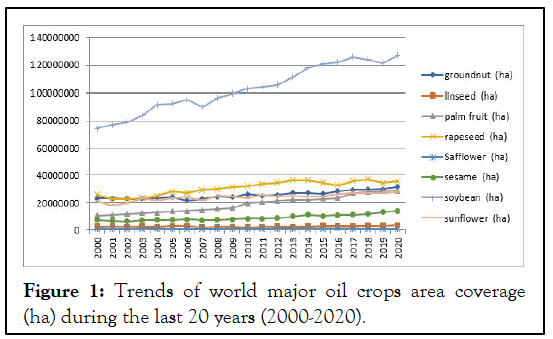
Figure 1: Trends of world major oil crops area coverage (ha) during the last 20 years (2000-2020).
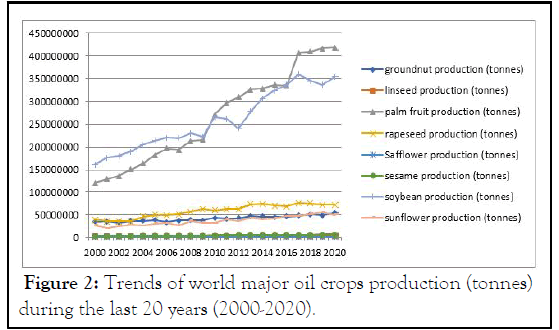
Figure 2: Trends of world major oil crops production (tonnes) during the last 20 years (2000-2020).
In Ethiopia, groundnut ranked third after Noug and Sesame (Figure 3). Groundnut area coverage and production (Figure 4) showed increasing trend during 2014 up to 2020 as compared with other oil crops.
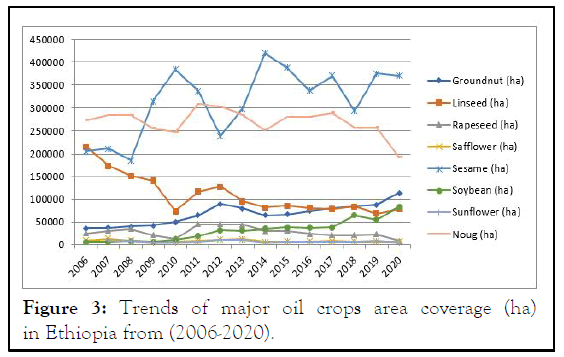
Figure 3: Trends of major oil crops area coverage (ha) in Ethiopia from (2006-2020).
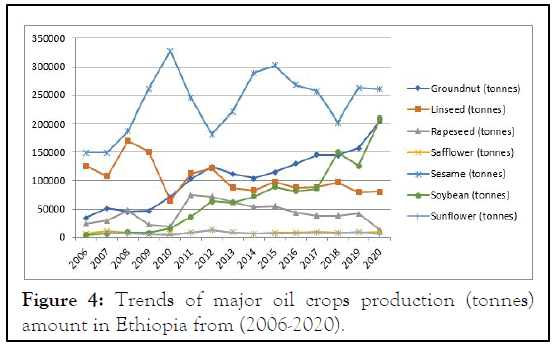
Figure 4: Trends of major oil crops production (tonnes) amount in Ethiopia from (2006-2020).
Currently, the total land coverage and production of groundnut is expected 113,515 ha and 2.05 million tonnes respectively, with productivity of 1.8 tonnes per hectare. The productivity has been increasing from 1 tonne to 1.8 tonnes per hectare (Figure 5). Production increment was highly contributed by area expansion (it accounts 143.74%) in Ethiopia than productivity (it accounts 1.5%).
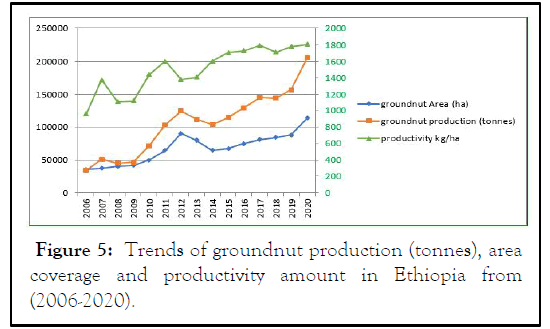
Figure 5: Trends of groundnut production (tonnes), area coverage and productivity amount in Ethiopia from (2006-2020).
Major groundnut producing regions
Oromia region constitutes the largest proportion of groundnut production areas and production of 57721.47 ha and 1.01 million tonnes respectively, with 1.75 tonnes of productivity. It accounts 49.3% production and 50.9% area coverage. On the other hand, Benishangul Gumz region is the second largest contributor in terms of groundnut production areas (28898.73 ha) and production 0.55 million tonnes with the productivity of 1.9 tonnes per hectare. It accounts 27.5% production and 25.5% area coverage of the country. In terms of productivity, Benishangul Gumuz region was higher than Oromya region (Figure 6). Other 25% production area and production found in Amhara, South nation nationality people, Harrary and Afar regions.
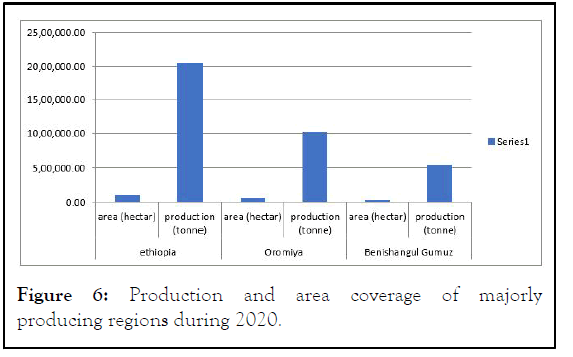
Figure 6: Production and area coverage of majorly producing regions during 2020.
Groundnut production constraints
The current average yield of groundnut is very low, with a national average of 1.8 tonnes per hectare, which is the lowest in the world. Groundnut production in Ethiopia highly affected by non-availability of improved varieties, poor seed production and delivery system, poor soil fertility and cultural practices, insect pests, diseases, etc. Weed interference with groundnut is a major constraint to optimum production, requiring considerable investment of human labor to minimize negative impact on pod yield. In addition, groundnut is susceptible to a number of foliar and soil borne diseases including early leaf spot (Cercospora arachidicola), late leaf spot (Cercosporidium personatum), rust (Puccinia arachidis) and the Groundnut Rosette Virus Disease (GRVD), transmitted by aphids (Aphis craccivora). These diseases can have a huge impact on yield and quality of groundnut seeds. In Ethiopia early leaf spot, late leaf spot and rust are major diseases. The leaf spot diseases cause yield reduction of 65% in areas with high rainfall.
Groundnut is particularly susceptible to contamination during growth and storage. Poor storage can lead to an infection by the mold fungus Aspergillus flavus, releasing the toxic and highly carcinogenic substance aflatoxin. The aflatoxin producing molds exist throughout the peanut growing areas and may produce aflatoxin in groundnut when conditions are favorable to fungal growth. According to Alemayehu, et al., different races of Aspergillus are common contaminants in groundnut growing regions across the dry lands of Ethiopia, which hinder the export market of the country. They identified some important factors that may contribute to aflatoxin contamination of groundnuts both pre-and post-harvest. These include: Weather conditions, seed and equipment sharing, planting time; harvesting time and methods; curing, drying and storage practices.
Marketing
More than 90% of produced groundnut consumed locally. Raw export quantity and value has been still negligible, become null during 2016 and 2017. On the other hand, import quantity and value showed an increasing pattern until 2015, but currently both import quantity and value decreasing. Maximum export amount and earning from it, was recorded during 2014 (Figure 7).
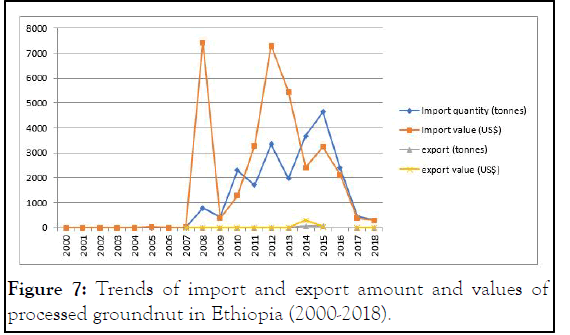
Figure 7: Trends of import and export amount and values of processed groundnut in Ethiopia (2000-2018).
Ethiopia exports higher amount of processed groundnut during 2019, but currently decreasing due to existence of aflatoxin (Figure 8).
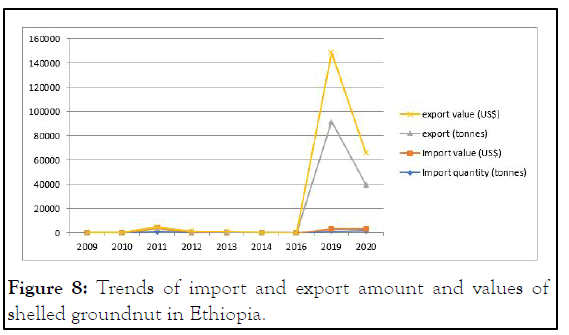
Figure 8: Trends of import and export amount and values of shelled groundnut in Ethiopia.
Groundnut oil is rich source of energy due to its high oil and protein contents. It is the most important multipurpose crop used for food and feed in developing countries. Area coverage production and productivity has been increasing and reached 113,515 ha, 205,069 tonnes 1.81 tonnes per hectare, respectively. Its production increment was highly dependent on area expansion rather than productivity (i.e., groundnut production increment was contributed by area expansion which accounted 143.7% during 2020). Currently, our increasing population demands huge amount of oil for food. However, the produced amount of oil crop cannot fulfill the demand. Therefore, research on varietal improvement, pest management options and other agronomic practices will be a solution.
[Crossref] [Google Scholar] [PubMed]
[Crossref] [Google Scholar] [PubMed]
Citation: Sendekie Y (2023) Review on; Groundnut and its Production Status in Ethiopia. Agri Sci Food Res. 14:148.
Received: 02-Dec-2022, Manuscript No. BFBP-22-20588; Editor assigned: 05-Dec-2022, Pre QC No. BFBP-22-20588 (PQ); Reviewed: 19-Dec-2022, QC No. BFBP-22-20588; Revised: 20-Feb-2023, Manuscript No. BFBP-22-20588 (R); Published: 01-Jun-2023 , DOI: 10.35248/2593-9173.23.14.148
Copyright: © 2023 Sendekie Y. This is an open-access article distributed under the terms of the Creative Commons Attribution License, which permits unrestricted use, distribution, and reproduction in any medium, provided the original author and source are credited.